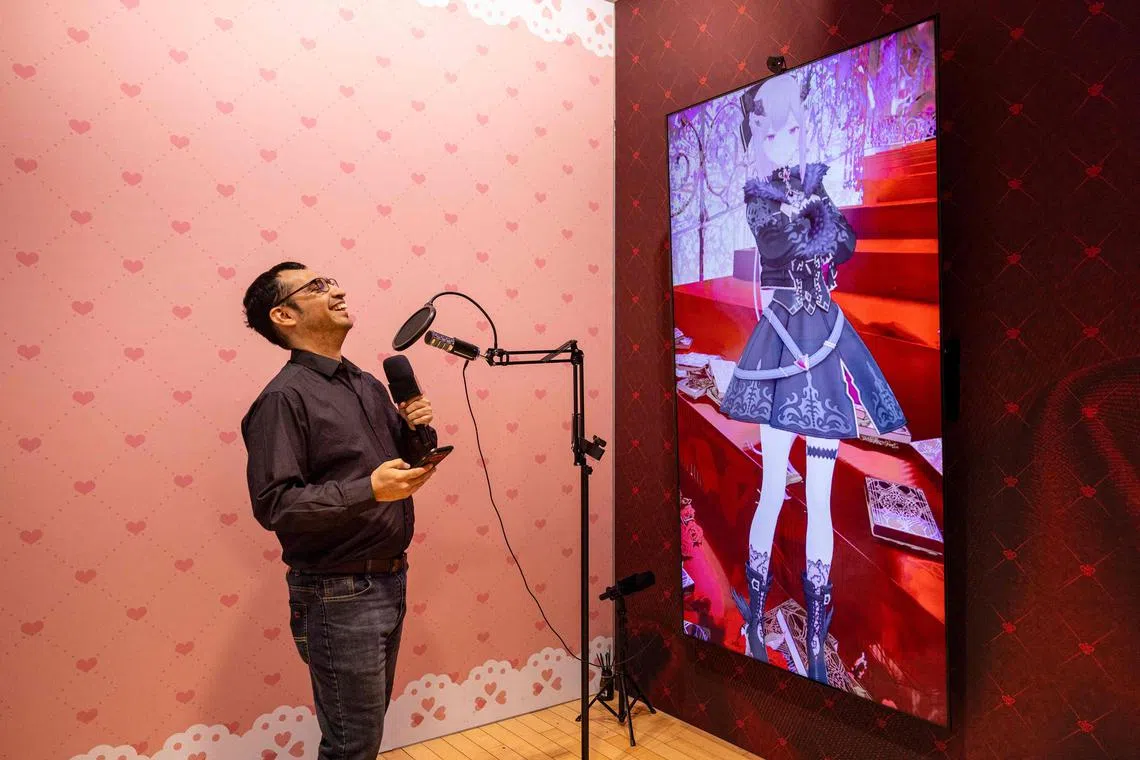Digital divas: Can Japan’s virtual YouTuber craze crack America?
Sign up now: Get insights on Asia's fast-moving developments

VTuber Mori Calliope performing for fans during a sold-out concert at the historic Hollywood Palladium in Los Angeles, California.
PHOTO: AFP
Follow topic:
TOKYO – Fans waved glow sticks at an animated character on stage, having packed a sold-out Hollywood concert hall to see their virtual idol perform – showcasing the global ambitions of Japan’s “VTuber” subculture.
Pink-haired musician and live streamer Mori Calliope looks just like a character from an anime cartoon, brought to life on stage through a hologram-like illusion.
Platforms like Netflix have helped take Japanese anime mainstream
“I don’t really like most streamers, but then when I discovered VTubers, I realised, ‘Hey, you know, I’m actually into this’,” said Calliope concert attendee Luigi Galvan.
“They look like anime characters. I like anime, so it was easy to get into the VTuber format that way,” he said.
The actors behind VTubers use motion capture techniques to communicate directly online with fans, who can pay to highlight their comments to the character and other viewers.
Nearly half of top VTuber agency Cover Corp’s virtual stars under its famous “hololive” brand speak primarily in English, not Japanese, and the company recently opened a US office to accelerate business in North America.
Tokyo-based QY Research predicts that the once-niche VTuber market will make almost US$4 billion (S$5.3 billion) annually worldwide by 2030, up from US$1.4 billion in 2024.
Around 4,000 fans attended the recent concert in Los Angeles, hololive’s first solo artist gig outside Japan.
Agence France-Presse asked Calliope – in her avatar form – if virtual YouTubers can really crack the US market.
“A couple of years ago, my firm stance was, ‘No, it won’t’,” said the star, who has more than 2.5 million YouTube subscribers.
“But these days, I like to be a little more hopeful,” added Calliope, whose actor wishes to remain anonymous, like most in the industry.

Fans posing as they await entry to the Hollywood Palladium for a sold-out concert by Virtual YouTuber Mori Calliope.
PHOTO: AFP
Korean rivals
Calliope, who playfully calls herself a “Grim Reaper” on a mission “to harvest souls”, likes black gothic outfits that contrast with her long pink hair.
An alter ego helps audiences “see and appreciate you for what lies within” instead of age or looks, allowing VTubers’ talent as musicians and raconteurs to shine, she said.
Calliope is one of Cover Corp’s more than 80 hololive VTubers, who together have 80 million YouTube subscribers globally, from Indonesia to Canada.
While Japan reigns supreme in the VTuber world, the country could face fierce competition from neighbouring cultural superpower South Korea in the coming years, warned Cover Corp’s chief executive Motoaki Tanigo.
“Aspiring K-pop singers have survived tough training and are already professional,” making the country a potential goldmine for VTuber actors, he said. “Can we easily find people like that in Japan? Of course not.”
South Korean VTuber companies “stand a good chance of growing exponentially” in the important US market because American audiences prefer polished performers, Mr Tanigo said.
In contrast, in Japan, fans often cherish the process of unskilled idols evolving, he explained.
Global expansion can also come with political risks
Human touch
While VTubers live in a digital world, Mr Tanigo said the human element behind the characters is an important part of their appeal.
“In principle, we won’t” use generative artificial intelligence technology to create new virtual talents, he said. “This whole business is based on fans’ desire to support someone because of their extraordinary artistic talent.”
“I think fans would be left feeling confused as to what, or who, they are rooting for.” he said.
Calliope fan Ian Goff, 23, agreed, saying he is fascinated by the actors behind VTubers, and their avatars are just the “cherry on top”.
“You can make a character with AI, but you can’t make a person with AI because that’s what makes the VTubers who they are,” the San Diego resident said.

A journalist interviewing VTuber Mori Calliope through a screen interface displaying the performer’s animated avatar.
PHOTO: AFP
In the rapidly growing, competitive industry, VTubers risk overexerting themselves by live streaming almost non-stop to grow their fandom.
“The longer they go on live streaming, the more fans watch them,” said Professor Takeshi Okamoto, who teaches media studies at Japan’s Kindai University.
“This can potentially amount to exploitation of their passion for the job.”
Yet the professor – who himself doubles as a zombie-like VTuber – sees a bright future for the industry.
With the popularity of virtual worlds like the Metaverse, “a day might come where it becomes more normal for us to live as avatars”, he said. “Our lives, then, could more seamlessly fuse with VTuber stars.” AFP

